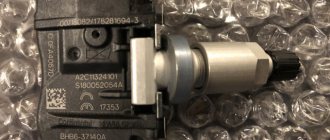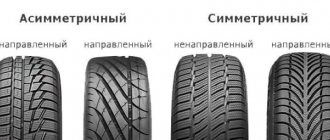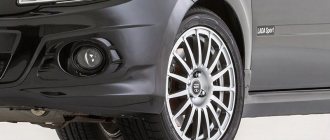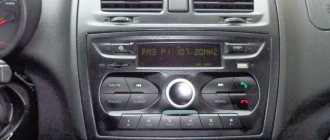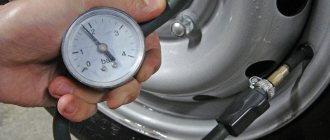Insufficient or too high tire pressure leads to reduced vehicle safety, deterioration of dynamic characteristics and causes increased fuel consumption. Therefore, the Mazda CX 5 uses special sensors.
They promptly detect and inform the driver about deviations in tire pressure from the norm.
Why check tire pressure?
The catalyst for many accidents is worn-out car tires, and the most serious tread damage occurs on overinflated or low tires.
In the first case, the center of the treadmill burns out - because of this defect, the braking distance increases and the number of accidents during emergency braking increases. In the second case, the edge of the tread wears off - this defect leads to loss of traction when maneuvering. However, incorrect tire pressure can lead to unpleasant consequences not only in the long term. A car driver who ignores the wheel control system signals faces the following problems:
- loss of dynamics - accelerating to 100 km/h in 7-10 seconds will no longer be possible;
- decreased controllability - the car skids when turning even on a dry road;
- increased fuel consumption - instead of the expected 4.6-9.8 per 100 km, the Mazda CX5 will “eat” up to 8-12 liters.
If the tire pressure monitoring sensor is on on the dashboard, do not ignore it, but try to deal with the problem that has arisen.
Chronology of main events
11,600 km – the right license plate light bulb falls out of the retainer.
36,224 km – alarm message about the oil level being too low.
45,997 km – excellent performance on snow.
50,521 km – high engine speeds after a “cold” start. Irritating at low temperatures.
80,440 km – replacement of front brake discs and pads.
87 389 – the “engine malfunction” light comes on. Another unplanned visit to the service.
The plastic covers on the bottom of the body are secured using plastic clips. But during the test they all got loose.
How does the Mazda CX5 tire pressure monitoring system work?
The wheel control system can be direct or indirect. The first technology relies on controllers built into the tire. The second system operates with data on the size of the wheel and the associated angular velocity. Mazda's designers opted for an indirect TPMS system.
The main components of the TPMS system are software and four sensors that monitor the angular speed of the wheel. A flat or overinflated tire changes its outer diameter, causing the angular speed to decrease or increase. The control sensor checks this indicator while driving, and the software compares the received data with the basic values. If the basic values deviate, the “Tire pressure error” signal lights up on the dashboard.
For the TPMS system to work, you need to initialize the software and sensors. Without prior activation and calibration, the number of false alarms increases (the signal will remain on even if the tire is correctly inflated).
Mazda CX-5 error p0171
Indications for contacting service are usually the following:
- the engine runs intermittently;
- jerks when moving;
- difficult starting;
- normal operation only when the engine is warm.
Diagnostics shows Mazda CX 5 error p0171 - “lean mixture”. Occurs during long-term fuel correction by 25%. Additionally, inspection of the cylinders with a stethoscope is used. As a rule, carbon deposits are found on the injector nozzles.
Popular tire models
- Yandex.Market rating: Yandex.Market: 4.5
Goodyear Eagle Sport TiresSeasonality: summer Spikes: no Diameter: 14 / 15 / 16
- Yandex.Market rating: Yandex.Market: 4.5
Goodyear UltraGrip Ice+ tires
Seasonality: winter Spikes: no Diameter: 14 / 15 / 16 / 17
- Yandex.Market rating: Yandex.Market: 4.5
Goodyear EfficientGrip Performance Tires
Seasonality: summer Spikes: no Diameter: 15 / 16 / 17 / 18 / 19 / 20
- Yandex.Market rating: Yandex.Market: 4.5
Goodyear UltraGrip Ice 2 tires
Seasonality: winter Spikes: no Diameter: 14 / 15 / 16 / 17 / 18 / 19
- Yandex.Market rating: Yandex.Market: 4.5
Goodyear Vector 4Seasons tires
Seasonality: all-season Spikes: no Diameter: 14 / 15 / 16 / 17 / 18
- Yandex.Market rating: Yandex.Market: 4.5
Goodyear Eagle Sport TZ tires
Seasonality: summer Spikes: no Diameter: 16 / 17 / 18
- Goodyear UltraGrip Arctic 2 tires
Seasonality: winter Spikes: yes Diameter: 16 / 17 / 18 / 19
- Yandex.Market rating: Yandex.Market: 4.5
Goodyear UltraGrip Ice SUV Tires
Seasonality: winter Spikes: no Diameter: 16 / 17 / 18 / 19 / 20
- Goodyear UltraGrip Arctic 2 SUV Tires
Seasonality: winter Spikes: yes Diameter: 17 / 18 / 19 / 20 / 21
- Yandex.Market rating: Yandex.Market: 4.5
Goodyear Wrangler All-Terrain Adventure tires with Kevlar
Seasonality: summer Spikes: no Diameter: 15 / 16 / 17 / 18 / 19 / 20
- Yandex.Market rating: Yandex.Market: 5
Goodyear Eagle Sport SUV TZ tires
Seasonality: summer Spikes: no Diameter: 17 / 18
- Yandex.Market rating: Yandex.Market: 4
Goodyear Wrangler HP All Weather Tires
Seasonality: summer Spikes: no Diameter: 15 / 16 / 17 / 18 / 19
- Yandex.Market rating: Yandex.Market: 4.5
Goodyear EfficientGrip SUV Tires
Seasonality: summer Spikes: no Diameter: 16 / 17 / 18 / 19 / 20 / 21 / 22
- Yandex.Market rating: Yandex.Market: 4
Goodyear UltraGrip Performance 2 Tires
Seasonality: winter Spikes: no Diameter: 16 / 17 / 21
- Yandex.Market rating: Yandex.Market: 5
Goodyear Eagle F1 SuperSport Tires
Seasonality: summer Spikes: no Diameter: 18 / 19 / 20 / 21
- Yandex.Market rating: Yandex.Market: 4.5
Goodyear Eagle F1 Asymmetric 3 SUV tires
Seasonality: summer Spikes: no Diameter: 17 / 18 / 19 / 20 / 21 / 22
- Goodyear Eagle F1 SuperSport RS Tires
Seasonality: summer Spikes: no Diameter: 21
How to initialize a TPMS system - step-by-step guide
- Inflate all four tires of your Mazda CX5 to the recommended internal pressure. For R17 format tires the recommended value is 2.3 bar, for R19 - 2.5 bar.
- Insert the key into the ignition. Turn it to the ON position and return it to LOCK. This way you activate the on-board network to which the air control system is connected.
- Wait at least 15 minutes. During this time, the on-board computer will catch the sensor signal, read its ID and register the bus controller. If you want to play it safe, wait 20 minutes.
- Start the car, start driving and pick up speed up to 25 km/h. Maintain this speed for 10 minutes while driving on a level road.
- Check the TPMS system indicator - it should show the correct pressure. If an error signal is on on the panel, press the TPMS SET button, which will reset the controller binding. After the reset, repeat the binding according to the described scheme.
Replacing spark plugs and high-voltage wires
Spark plugs in a car are the main components for igniting the fuel mixture. If the spark plugs are faulty, the spark will not be supplied correctly to ignite the gasoline mixture. Faulty spark plugs often result in a lack of spark or an incorrect spark interval, which results in the engine not running properly. If the spark plugs do not work properly during acceleration, especially from a standstill, you may feel slight jolts.
What are the reasons for spark plug failure:
Most spark plugs in pre-1996 vehicles need to be replaced every 25,000 to 30,000 kilometers. In newer cars, spark plugs last more than 150,000 km. However, these scheduled spark plug replacement intervals may be reduced by various factors related to fuel quality and driving style.
What to do:
If your spark plugs have not been changed for a long time, or you feel failures in the engine operation associated with ignition, then you must immediately replace them with new ones without delay.
Do not try to save money by untimely replacement of spark plugs, since the cost of spark plugs is not very expensive, as well as the work of replacing them. By replacing old spark plugs, you will improve engine performance and reduce your vehicle's fuel consumption. Changing spark plugs yourself is quite easy. Basically, they are easily accessible under the hood of the car. You need a regular spark plug wrench to remove the spark plugs from the engine. It is also advisable to monitor the condition of high-voltage wires, since over time they can become unusable and allow electricity to pass through, which is transferred to the spark plugs, which will reduce the strength of the spark. Remember that regularly replacing spark plugs, in accordance with your car’s maintenance schedule, protects your exhaust catalyst from breakdowns and also improves engine performance!
My problems just started on the regular 95. I have never used additives before in principle, on any car before the CX-5. On the CX-5 for almost 2.5 years, Lil 95 from Shell, everything was ok. Then it started to interfere with the usual 95 from Lukoil and off we went (the traction was gone, the engine roared and didn’t really move, even the automatic transmission shifts during kickdown began to occur with some delay).
I left work on Friday and started it. Here is the first Check engine (engine check required). The oil is fine, there is no unnecessary noise. 37 thousand on the odometer. I restarted it several times (5), and even drove it today. Everything in terms of dynamics seems to be normal, but the light stays on. I made an appointment with the OD on Tuesday. ELM327 no, I can’t check it myself ((Tomorrow on foot. I’ll have to go to the polls
The red Mazda CX-5 set out on a long testing journey on May 13, 2013. Testing of the crossover by the editors of the German magazine “Auto Bild” took place in strict accordance with the plan. From the very first kilometers, the SUV began to collect positive reviews. Most entries praise the 2.2-litre turbodiesel and the well-balanced, comfortable chassis. As you probably guessed, this combination made the Japanese crossover the most popular vehicle for long trips.
During testing, we were pleased with such pleasant details as USB and AUX connectors in the armrest and fast-acting heated seats. After 15,000 km, the test editor summarized: “A pleasant car. Suspension, engine, seats, effective navigation system and spacious interior - the car is four and a half points on a 5-point scale.”
Despite the fact that a number of shortcomings were soon discovered, none of them changed the positive attitude towards the Mazda CX-5. Among the most annoying little things, it is worth noting the following: a license plate light that constantly falls out of its holder, door pockets that are too small, carelessly laid carpet and poor rear visibility.
The carpet is attached very weakly: one movement of the hand, and it forms a slide.
Unfortunately, the idyll soon ended. At the 34,224 km mark, while driving on the highway, the Mazda CX-5 revealed its dark mask. The engine warning light came on and the oil level was too low. This scared the driver seriously. As if this were not enough, the on-board computer warned of the risk of engine seizure.
I had to react quickly: braking, moving into the emergency lane and turning off the engine. The hood is up, the dipstick is in your hands, and on it... there is a normal oil level. After starting the engine, all messages disappeared, as if by magic. Is it possible that this was a false alarm?
Not really. From that moment on, the message appeared quite regularly, and then disappeared again. Of course, this is not a normal situation. Therefore, it was decided to reduce the waiting time for the next maintenance scheduled for 40,000 km, and visit the service now. After draining the old oil, it was discovered that the lubricant was very worn and diluted. It’s strange that the on-board computer did not suggest rushing to visit the service. Perhaps Mazda engineers should take care of this...
When does the control system fail?
The indirect TPMS system is not a 100% reliable method of pressure control. It happens that it gives an error in which the signal is on, and the pressure in the wheel is normal. Most often, such a failure occurs when tires of different models are installed on car rims. Another reason may be driving on a bumpy road, during which the wheel dimensions change for natural reasons. The error can also be seen when taking a turn in a long arc.
The sensor does not operate at speeds below 25 km/h, or when tires with rigid sides (Run-Flat models) are installed on the vehicle. Another reason for the lack of a signal may be the replacement of the disk, during which they forgot to install the angular velocity controller.
Types of sensors
Based on the type of mounting, sensors are classified into:
- External. They are manufactured in the form of standard caps that are attached to the tire. The main advantages include low cost and ease of operation. The main disadvantage is that any passerby can easily twist this part to sell or install it on their car. Also, when driving at high speeds, there is a risk of losing a part or damaging it.
- Internal. They are installed on the air duct through which the tire is inflated. The design is attached to the disc under the tire, so it is completely invisible. Data is sent to the monitor or smartphone screen via Bluetooth via radio communication.
